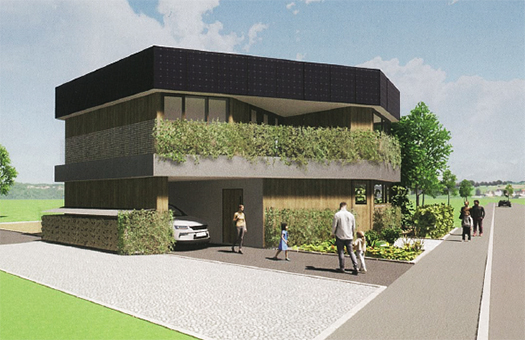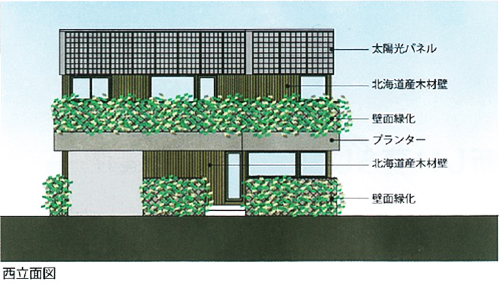

「北海道は課題の先進地」というやや自虐感のあるコトバを北海道の住宅研究機関である「北総研」からの情報発信でよくみかける。まことに言い得て妙だと思わされる。
きのう触れたように明治の開拓期以来、この地に旺盛に殖民することが「国防」そのものであったことで、日本建築としてはじめて本格的な「寒冷気候対策」に向き合うようになった。やはり日本社会は温暖アジアの島嶼という地球的地理条件のなかで成立した人間社会であり、さらに主要な食糧生産物としてコメという亜熱帯気候を発祥とする文化社会。
そういう社会の中では、気候風土条件として過酷な積雪寒冷ということは忌避してきた地域だったのでしょう。東北北部ですら歴史年代を通じて寒冷気候によるコメ作不振が飢饉として社会を揺さぶり続けてきていた。
明治という革命は、欧米列強に対して独立を確保するために社会全体を革新させるものだったのでしょうが、そのなかで北海道の殖民推進、そしてそのための「住居」技術革新は必須要件。北海道開拓に対して深く関わった後の薩摩閥の総理大臣・黒田清隆などは、寒冷地住宅の技術推進を先頭に立って行ってきた。あるときなど木造建築工事の現場で、いきなり自ら屋根に上って造作工事に飛び入り参加した事跡が伝えられている。
そういうことから日本建築全体にとって北海道はまさに「課題の先進地」であり続けた。そのことが現代にまで「伝統」としてあって開拓使以来のそうした使命感から寒冷地住宅技術、それも断熱気密といった技術革新のメッカになっていった。そういう技術が本州以南地域に還流するようになっていった一方、今度はエネルギー革新ということで太陽光発電というものと向き合わされることになった。
そもそも積雪条件のほとんどない温暖地域の建物の屋根を利用するエネルギー装置であるものを、積雪条件の「課題の先進地」北海道として受け止めることになったのだ。
そこからPV壁面設置という大きな方向性は打ち出されてきている。
しかし北海道人としてはやはり「不条理」という気分はやむを得ない。読者の方から「南側に大きな建物が建つ可能性が低い場所なら壁面PVは有効なのでしょう。国交省がPVを推進するなら日照権をめぐる法制度を整備すべきではないでしょうか。」という至極まっとうなご意見もあった。
まったくその通りなのですが、一方でたしかに壁面PVの応用技術開発にもっとも似合っているのも、比較的に敷地条件にゆとりのある北海道であるでしょう。高断熱高気密という技術を開発し波及させてきた北海道としてはまた新たな進化条件を提示されているのだと思うしかないと。
デザインという意味でも、こういう桎梏条件はあらたなものを生み出させる可能性がある。上に示したデザインはひとつの「方向性」を示唆しているとも思えた。
English version⬇
Hokkaido, the Advanced Region of the Issue, Will Clear the PV Wall?
Hokkaido has responded to the demands of Japanese national society through the development of highly insulated and airtight technologies. Now, is there another demand for “evolution” in residential energy?
The somewhat self-deprecating phrase “Hokkaido is an advanced area of issues” is often used by the Hokkaido Institute of Housing Research (HIROSOKEN) to convey information. This is a very apt description.
As I mentioned yesterday, since the Meiji era (1868-1912), when the Japanese colonization of this land was a matter of “national defense” itself, Japanese architecture has been dealing with “cold climate countermeasures” in earnest for the first time. Japanese society is, after all, a human society established in the global geographical conditions of warm Asian islands, and it is also a cultural society that originated in a subtropical climate, where rice is the main food product.
In such a society, the harsh climatic conditions of snow and cold were probably avoided. Even in the northern Tohoku region, poor rice production due to the cold climate had been shaking the society as a famine throughout the historical period.
The Meiji Revolution was a revolution that revolutionized the entire society in order to secure independence from the Western powers, and the promotion of colonization of Hokkaido and the innovation of “housing” technology were essential to this. Kiyotaka Kuroda, the future prime minister of the Satsuma clan, was deeply involved in the development of Hokkaido, and he spearheaded the promotion of cold-weather housing technology. It is said that on one occasion, he even climbed onto the roof of a wooden construction site and jumped in to participate in the work.
For this reason, Hokkaido has always been an “advanced place of challenges” for Japanese architecture as a whole. This has remained a “tradition” to the present day, and the sense of mission since the pioneering mission has made Hokkaido a Mecca for technological innovation in cold-weather housing, including thermal insulation and airtightness. While these technologies were being returned to regions south of Honshu, the region was also confronted with solar power generation as a form of energy innovation.
Hokkaido, an “advanced region” in terms of snowfall conditions, was to accept this energy device that utilizes the roofs of buildings in warmer regions with little or no snow cover.
From there, the major direction of PV wall installations has been developed.
However, as a Hokkaido-er, I cannot help but feel that this is “absurd. One of our readers commented to us, “If there is little chance of a large building being erected on the south side, a wall PV system would be effective. If MLIT is going to promote PV, shouldn’t they improve the legal system surrounding the right to sunshine?” This is a perfectly reasonable opinion.
While this is absolutely true, it is also true that Hokkaido, with its relatively spacious site conditions, is the most suitable place for the development of wall PV application technology. Hokkaido, which has developed and spread the technology of high thermal insulation and airtightness, must think that it is being presented with new conditions for evolution.
In terms of design, these kinds of fetters may lead to the creation of something new. The design shown above may suggest a “direction”.
Posted on 3月 15th, 2024 by 三木 奎吾
Filed under: 住宅マーケティング







コメントを投稿
「※誹謗中傷や、悪意のある書き込み、営利目的などのコメントを防ぐために、投稿された全てのコメントは一時的に保留されますのでご了承ください。」
You must be logged in to post a comment.